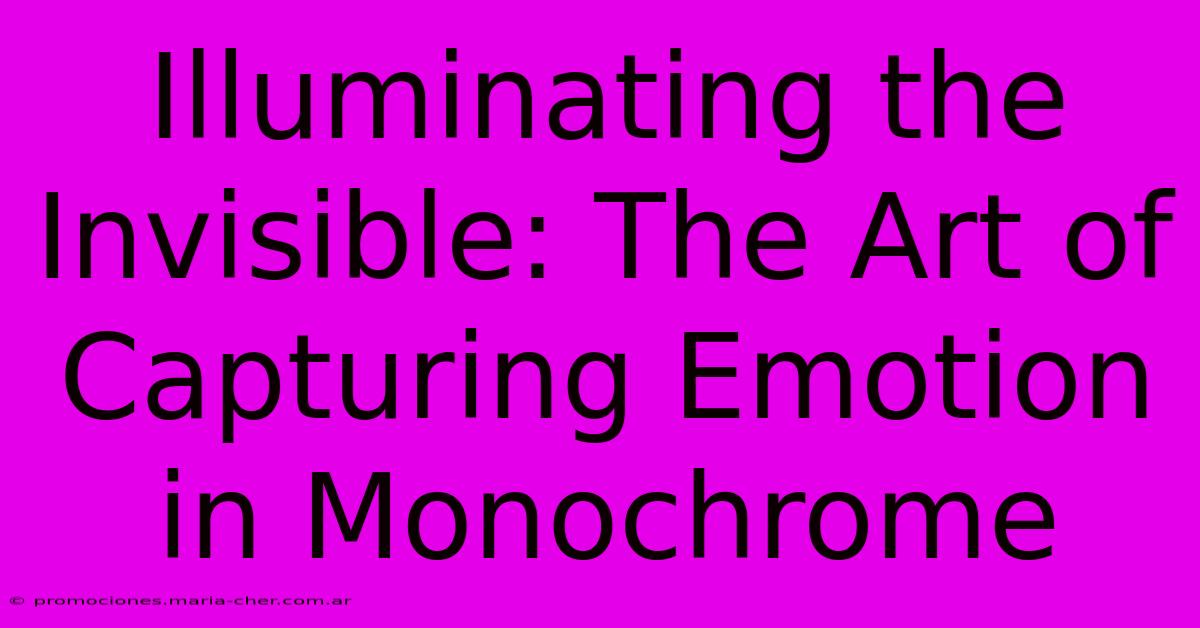Illuminating The Invisible: The Art Of Capturing Emotion In Monochrome

Table of Contents
Illuminating the Invisible: The Art of Capturing Emotion in Monochrome
Monochrome photography, often perceived as simplistic, is a powerful medium capable of evoking profound emotions. By stripping away the distractions of color, monochrome photography forces the viewer to focus on the core elements of the image: light, shadow, texture, and composition. This focus allows for a raw, unfiltered emotional connection that color photography sometimes struggles to achieve. This article delves into the techniques and artistic considerations that contribute to the captivating power of monochrome emotion.
The Power of Absence: Why Monochrome Works
The absence of color isn't a limitation; it's an opportunity. When color is removed, the subtleties of light and shadow become dramatically amplified. A single, well-placed highlight can evoke a sense of hope, while deep shadows can communicate mystery or even fear. This heightened contrast allows for a more direct emotional impact.
Focusing on the Essentials
Consider these key aspects when aiming for emotional impact in monochrome:
-
Light and Shadow: These are the building blocks of monochrome photography. Mastering the interplay of light and shadow is crucial for conveying mood and emotion. Dramatic chiaroscuro can create a sense of drama and tension, while soft, diffused light might suggest tranquility or peace.
-
Texture and Tone: Monochrome photography beautifully reveals texture. The roughness of a weathered surface, the smoothness of skin, the intricate details of fabric – these elements are brought to the forefront in the absence of color. The tonal range, from deep blacks to bright whites, adds further depth and emotional weight.
-
Composition and Subject Matter: A strong composition is vital. Consider the rule of thirds, leading lines, and negative space to guide the viewer's eye and create a visually engaging image. The choice of subject matter also plays a crucial role in conveying emotion. A portrait of a weathered face might evoke feelings of wisdom and resilience, while a landscape shot might convey a sense of vastness and solitude.
Technical Aspects of Monochrome Mastery
While artistic vision is paramount, understanding the technical aspects enhances the emotional impact.
Choosing the Right Black and White Conversion Method
Several methods exist for converting color images to monochrome:
-
In-Camera Monochrome: Shooting directly in monochrome allows for greater control over the tonal range and contrast.
-
Post-Processing Conversions: Software like Adobe Photoshop and Lightroom offers various conversion techniques, including black and white adjustments, channel mixing, and split toning. Experimentation is key to finding the best approach for your image.
-
Black and White Film: For a truly classic look, shooting on black and white film offers unique characteristics and grain structure that can enhance the emotional impact of your photographs.
Evoking Specific Emotions Through Monochrome
Monochrome isn't a one-size-fits-all approach. Different techniques can be employed to evoke specific emotions:
-
High Contrast for Drama: Bold contrasts between light and shadow create a powerful and dramatic effect, perfect for conveying intense emotions like fear, anger, or excitement.
-
Soft Contrast for Serenity: Subtle tonal variations and soft lighting create a peaceful and serene mood, ideal for conveying tranquility, calmness, or nostalgia.
-
Grainy Texture for Authenticity: A grainy texture, often associated with older film photography, can add a sense of authenticity and rawness, enhancing the emotional impact of gritty or documentary-style images.
Beyond the Image: Sharing Your Monochrome Vision
Once you've captured your emotionally resonant monochrome image, consider how you share it with the world.
-
Online Platforms: Utilize platforms like Instagram, Flickr, and 500px, which provide excellent opportunities for showcasing your work and engaging with other photographers. Use relevant hashtags to increase visibility, such as #monochromephotography, #blackandwhitephotography, #emotionalphotography.
-
Print Exhibitions and Galleries: Consider exhibiting your work in physical spaces to connect with viewers on a more intimate level.
Conclusion:
Mastering the art of capturing emotion in monochrome photography is a journey of exploration and experimentation. By understanding the interplay of light, shadow, texture, and composition, and by utilizing appropriate technical techniques, you can create images that resonate deeply with viewers on an emotional level. Embrace the power of absence, and let the invisible illuminate the beauty and emotion within your subjects.

Thank you for visiting our website wich cover about Illuminating The Invisible: The Art Of Capturing Emotion In Monochrome. We hope the information provided has been useful to you. Feel free to contact us if you have any questions or need further assistance. See you next time and dont miss to bookmark.
Featured Posts
-
Touchdown Time For Funny Football Names Brace Yourself For The All Pro Dad Jokes
Feb 06, 2025
-
Hack The System The Insiders Secret To Maximizing Wednesdays Email Marketing Magic
Feb 06, 2025
-
Stunning Revelation From Crimson To Blush Unraveling The Language Of Rose Hues
Feb 06, 2025
-
Unlock Your Cameras Full Potential The Revolutionary C Fexpress Type A Explained
Feb 06, 2025
-
The Camera Lens That Turns The Mundane Into The Mesmerizing Holga The Master Of Unpredictability
Feb 06, 2025
